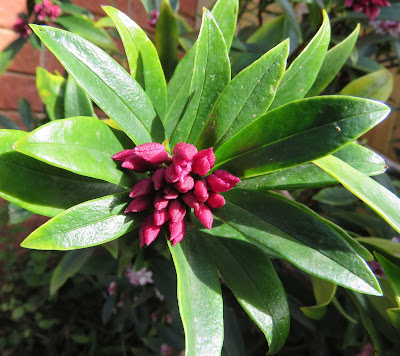Don't snort the autumn-winter-sprinter daphne
This Winter Daphne has been flowering since we moved into our home in April. By my reckoning that's an Autumn, Winter and now Sprinter Daphne. You see it described as flowering in mid to late winter and early spring, which is about right, but not a great basis for a common name.
Daphne odora is an enduring plant. It survives in a dull little corner in our new backyard as it does throughout Melbourne and the greater universe. It smells, a little - we debate here about just how much perfume it produces and this seems to depend on your 'nose'. Sometimes the perfume is described as delicate, which seems about right.
Oh and most parts of the plant - particularly the bark and berries - are poisonous so take care when handling, and please sniff rather than snort. Just a few berries = death of a child.
We have one of the green-leaved, pink-tinged-flowered forms. The flowers are small but the the port-wine colour of the buds, later flushed through the petals are attractive, is nothing to be sneezed at.
The shrub is about one metre high and thrives on neglect (in a cool, sheltered, east-facing position...). You read about them turning up their roots now and then but this one was obviously well established at some time and seems to be with us forever ... or at least the 8-10 years life span usually quoted for this species.
It's a plant for the cooler parts of Australia, and perhaps London... Many of the daphne species are actually native to the Mediterranean region. We had a local UK one, Daphne laureola, by our back door when we lived in London, inside Kew Gardens. Sadly it had been hacked back before we arrived and we ended up removing it almost entirely due to its inability to return to anything resembling an attractive habit.
Somewhat gratuitously (and you know I like doing this) here is the back of the house at Kew, and a close up of the back door. You can see the daphne stump in the second picture, surrounded by replacement plantings. I can't recall if it sprung back to life or not, but perhaps it too had life span of around a decade.






Comments